Introduction to smart wearables in active aging
In most modern societies that technology and medicine have dramatically advanced, the ageing population is increasing due to the extension of life expectancy (Gu, Andreev & Dupre, 2021). However, the increase in life expectancy does not mean that the ageing population is thriving; longevity without independence and dignity, can feel somewhat not worthy. We all have witnessed in one way or other seniors who might live until the age of 95, but spent their last decade in bed, totally dependent on medicines and taken care of from other people; seniors who spent their last years in caring houses feeling miserable, with the only hope to get a visit from their children once in a while; seniors who live alone with no social connections feeling loneliness and disconnected from the rest of the world.
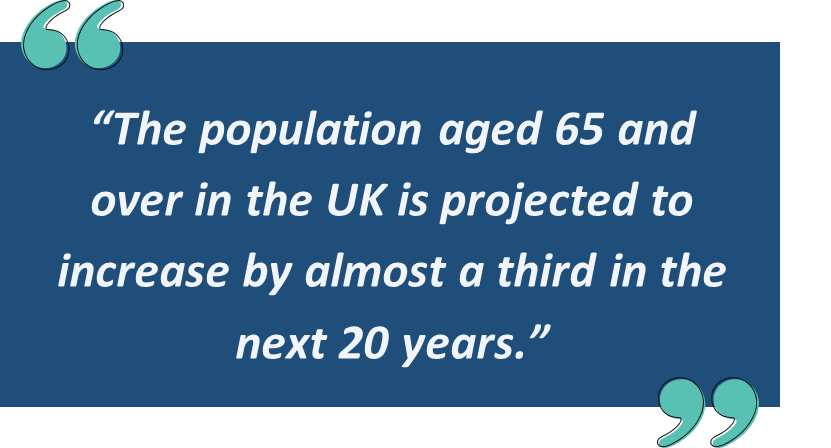
Source: ONS (2022), Principal projection – UK population in age groups. Available at: ONS Population Projections
So, is the increase in life expectancy the key ingredient to the recipe called successful and fulfilling life? It seems that is not. Seniors need more than that to achieve what scientists call “successful ageing”. Successful ageing is based on three components: limited disease-associated disability, high cognitive and physical function, and continued engagement with life (Morley, 2015). It has also been suggested that successful ageing can be achieved through ageing-in-place, a concept that illustrates the continued living at home, while maintaining independence, social contact, and dignity, profoundly impacting seniors’ health and mental state, and it is perceived by seniors as more desirable, graceful, and fulfilling (Puri et al., 2017).
Nevertheless, no matter how appealing this concept sounds, it does not directly combat the fact that seniors still suffer from degenerative diseases and age-related illnesses, which are the main causes of mortality nowadays (Araullo & Potter, 2016). This has led to the increase of wearable health monitoring technologies, from medication reminders and fall prevention and detection to physical condition data directly transmitting to medical centres (Li et al., 2019; Puri et al., 2017). Is there, though, another way that can prevent or at least decrease the impact of this situation? Thankfully, there is.
En la mayoría de las sociedades modernas en las que la tecnología y la medicina han avanzado drásticamente, la población envejecida está aumentando debido a la prolongación de la esperanza de vida (Gu, Andreev y Dupre, 2021). Sin embargo, el aumento de la esperanza de vida no significa que la población envejecida esté prosperando; la longevidad sin independencia y dignidad puede no merecer la pena. Todos hemos visto alguna vez personas mayores que han vivido hasta los 95 años, pero que han pasado su última década en cama, totalmente dependientes de medicamentos y atendidos por otras personas; personas mayores que han pasado sus últimos años en residencias sintiéndose miserables, con la única esperanza de recibir una visita de sus hijos de vez en cuando; personas mayores que viven solas, sin contacto social, en soledad y desconectadas del resto del mundo.
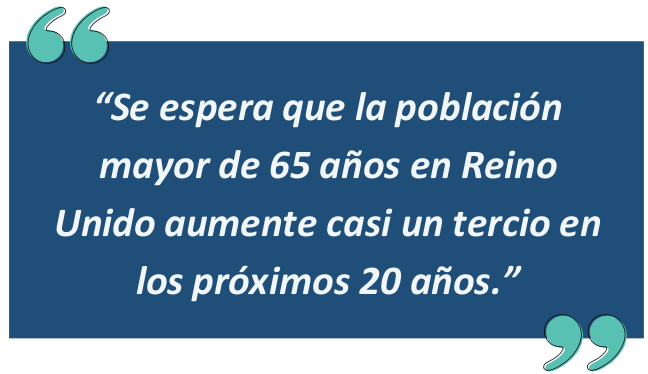
Fuente: ONS (2022), Principal projection – UK population in age groups. Disponible en: ONS Population Projections
Entonces, ¿es el aumento de la esperanza de vida el ingrediente clave en la receta de una vida satisfactoria y plena? Parece que no. Las personas mayores necesitan más para lograr lo que los científicos llaman «envejecimiento exitoso». El envejecimiento exitoso se basa en tres componentes: poca discapacidad asociada a enfermedades, funciones cognitivas y físicas buenas, y un compromiso continuo con la vida (Morley, 2015). También se ha sugerido que el envejecimiento exitoso puede lograrse a través del envejecimiento en el lugar, un concepto que ilustra la vida continuada en el hogar a la vez que se mantiene la independencia, el contacto social y la dignidad, lo que tiene un profundo impacto en la salud y el estado mental de las personas mayores, y es percibido por las personas mayores como más deseable, atractivo y satisfactorio (Puri et al., 2017).
Sin embargo, por muy atractivo que suene este concepto, no combate directamente el hecho de que las personas mayores sigan padeciendo enfermedades degenerativas y enfermedades relacionadas con la edad, que son las principales causas de mortalidad en la actualidad (Araullo y Potter, 2016). Esto ha provocado el aumento de las tecnologías ponibles que monitorean la salud, desde recordatorios para medicación y prevención y detección de caídas hasta la transmisión directa de datos sobre el estado físico a los centros médicos (Li et al., 2019; Puri et al., 2017). Sin embargo, ¿existe algo más que pueda prevenir o, al menos, disminuir el impacto de esta situación? Afortunadamente, sí.
Nella maggior parte delle società moderne, in cui la tecnologia e la medicina hanno fatto passi da gigante, la popolazione anziana sta aumentando grazie all'allungamento dell'aspettativa di vita (Gu, Andreev & Dupre, 2021). Tuttavia, l'aumento dell'aspettativa di vita non significa che la popolazione anziana stia prosperando; la longevità senza indipendenza e dignità può sembrare in qualche modo non degna. Tutti noi abbiamo assistito, in un modo o nell'altro, ad anziani che potrebbero vivere fino a 95 anni, ma che hanno trascorso i loro ultimi dieci anni a letto, totalmente dipendenti da farmaci e accuditi da altre persone; anziani che hanno trascorso i loro ultimi anni in case di riposo sentendosi infelici, con l'unica speranza di ricevere una visita dai loro figli di tanto in tanto; anziani che vivono da soli senza legami sociali sentendosi soli e disconnessi dal resto del mondo.

Fonte: ONS (2022), Proiezione principale - Popolazione del Regno Unito in gruppi di età. Disponibile all'indirizzo: ONS Population Projections
Quindi, l'aumento dell'aspettativa di vita è l'ingrediente chiave della ricetta chiamata vita di successo e soddisfacente? Sembra di no. Gli anziani hanno bisogno di qualcosa di più per raggiungere quello che gli scienziati chiamano "invecchiamento di successo". L'invecchiamento di successo si basa su tre componenti: limitata disabilità associata a malattie, elevata funzionalità cognitiva e fisica e impegno continuo nella vita (Morley, 2015). È stato anche suggerito che l'invecchiamento di successo può essere raggiunto attraverso l'ageing-in-place, un concetto che illustra la continuazione della vita a casa, mantenendo l'indipendenza, i contatti sociali e la dignità, che ha un profondo impatto sulla salute e sullo stato mentale degli anziani ed è percepito da questi ultimi come più desiderabile, aggraziato e appagante (Puri et al., 2017).
Tuttavia, per quanto attraente possa sembrare questo concetto, non combatte direttamente il fatto che gli anziani soffrono ancora di malattie degenerative e patologie legate all'età, che sono le principali cause di mortalità al giorno d'oggi (Araullo & Potter, 2016). Questo ha portato all'aumento delle tecnologie indossabili per il monitoraggio della salute, dai promemoria per i farmaci alla prevenzione e al rilevamento delle cadute, fino alla trasmissione diretta dei dati sulle condizioni fisiche ai centri medici (Li et al., 2019; Puri et al., 2017). Esiste, tuttavia, un altro modo per prevenire o almeno ridurre l'impatto di questa situazione? Fortunatamente sì.
A legtöbb modern társadalomban, ahol a technológia és az orvostudomány drámai fejlődésen ment keresztül, a várható élettartam meghosszabbodása miatt egyre nő az idős népesség számaránya (Gu, Andreev & Dupre, 2021). A várható élettartam emelkedése azonban nem feltétlenül örömhír az időseknek — függetlenség és méltóság nélkül a hosszú élet is méltánytalannak tetszhet. Különböző formában mindannyian találkoztunk a jelenséggel, hogy bár valaki 95 évig élt, de utolsó évtizedét ágyban, mások gondoskodására utalva, gyógyszerfüggőségben élte le, vagy boldogtalanul egy gondozóházban, reménykedve, hogy gyermekei néhanapján meglátogatják, vagy társas kapcsolatok nélkül, magányosan, a világtól elvágva töltötte.
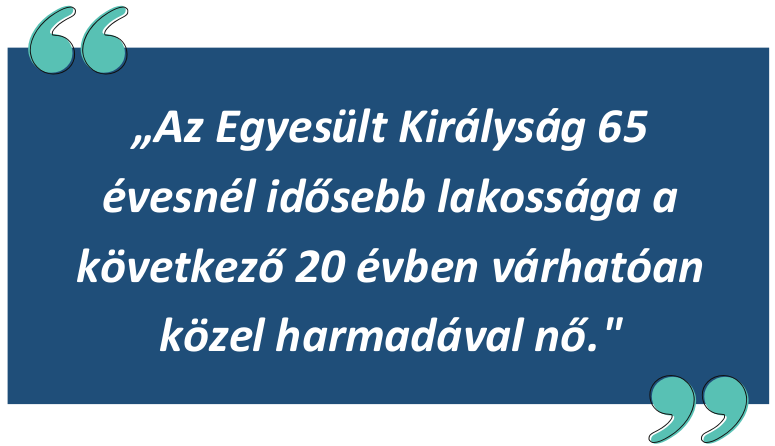
Forrás: ONS (2022), Principal projection – UK population in age groups. Elérhetősége: ONS Population Projections
A várható élettartam emelkedése elegendő volna a sikeres és teljes élethez? Úgy tűnik, nem. Az időseknek ennél többre van szükségük, arra, hogy a tudósok kifejezésével élve “jól sikerüljön megöregedniük”. Három dolog kell a jól sikerült öregkorhoz: korlátozott mértékű betegséggel összefüggő fogyatékosság, magas szintű kognitív és fizikai aktivitás, és az életben való folyamatos részvétel (Morley, 2015). A testi és lelki egészség megőrzésére jótékony hatással lehet az “egy helyben öregedés”, azaz a függetlenség, a társas kapcsolatok, és a méltóság megőrzése mellett a saját otthonban maradás. Az idősek vonzóbb, teljesebb, emberi méltóságukat kevésbé sértő opciónak élik meg, ha nem kell elköltözniük (Puri et al., 2017).
Mindazonáltal, akármilyen jól is hangzik ez az elképzelés papíron, tény, hogy a halálozás legfőbb okai továbbra is az időseket sújtó degeneratív, az életkorral összefüggő betegségek (Araullo & Potter, 2016). Emiatt terjednek a viselhető egészségmegfigyelési technológiák, például a gyógyszeres emlékeztetők, az esésfelimerő és megelőző rendszerek, vagy a fizikai állapotadatokat az egészségügyi központokba továbbító eszközök (Li et al., 2019; Puri et al., 2017). Van-e azonban más lehetőségünk, hogy megelőzzük vagy legalábbis csökkentsük a helyzet okozta károkat? Szerencsére igen.
In de meeste moderne samenlevingen waarin technologie en geneeskunde dramatisch zijn gevorderd, neemt de vergrijzing van de bevolking toe als gevolg van de verlenging van de levensverwachting (Gu, Andreev & Dupre, 2021). De stijging van de levensverwachting betekent echter niet dat de vergrijzende bevolking floreert; Een lang leven zonder onafhankelijkheid en waardigheid, kan enigszins onwaardig aanvoelen. We zijn allemaal op de een of andere manier getuige geweest van senioren die misschien tot de leeftijd van 95 jaar zouden kunnen leven, maar hun laatste decennium in bed doorbrachten, volledig afhankelijk van medicijnen en verzorging door andere mensen; senioren die hun laatste jaren in verzorgingstehuizen doorbrachten met een ellendig gevoel, met als enige hoop af en toe bezoek van hun kinderen te krijgen; Senioren die alleen wonen zonder sociale connecties, die zich eenzaam voelen en niet verbonden zijn met de rest van de wereld.
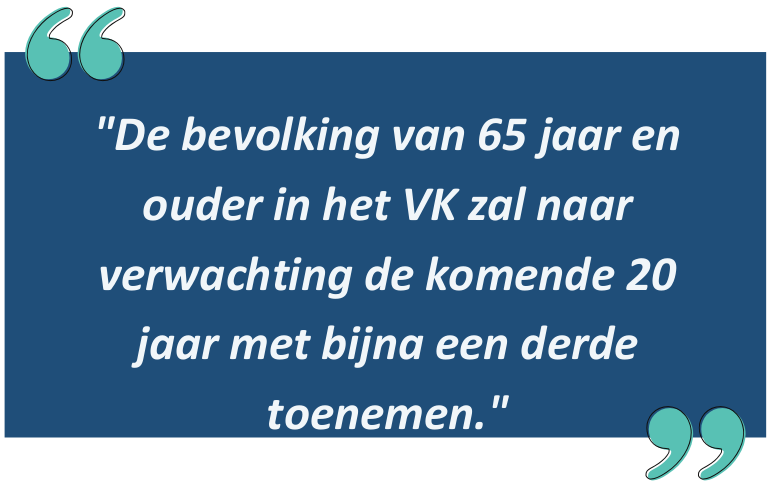
Bron: ONS (2022), Voornaamste projectie – Britse bevolking in leeftijdsgroepen. Beschikbaar op: ONS Population Projections
Dus, is de toename van de levensverwachting het belangrijkste ingrediënt van het recept dat succesvol en bevredigend leven wordt genoemd? Het lijkt erop dat dit niet het geval is. Senioren hebben meer nodig dan dat om te bereiken wat wetenschappers 'succesvol ouder worden' noemen. Succesvol ouder worden is gebaseerd op drie componenten: beperkte ziekte gerelateerde invaliditeit, hoge cognitieve en fysieke functionering en voortdurende betrokkenheid bij het leven (Morley, 2015). Er is ook gesuggereerd dat succesvol ouder worden kan worden bereikt door veroudering ter plaatse, een concept dat de voortzetting van het thuis wonen illustreert, met behoud van onafhankelijkheid, sociaal contact en waardigheid, wat een grote invloed heeft op de gezondheid en mentale toestand van senioren, en het wordt door senioren gezien als meer wenselijk, gracieus en bevredigend (Puri et al., 2017).
Maar hoe aantrekkelijk dit concept ook klinkt, het bestrijdt niet direct het feit dat senioren nog steeds lijden aan degeneratieve ziekten en ouderdomsziekten, die tegenwoordig de belangrijkste doodsoorzaken zijn (Araullo & Potter, 2016). Dit heeft geleid tot de toename van draagbare technologieën voor gezondheidsmonitoring, van medicatieherinneringen en valpreventie en -detectie tot gegevens over de fysieke toestand die rechtstreeks naar medische centra worden verzonden (Li et al., 2019; Puri et al., 2017). Is er echter een andere manier om de impact van deze situatie te voorkomen of op zijn minst te verminderen? Gelukkig is die er.
Nas sociedades modernas, onde os avanços da tecnologia e da medicina têm sido notáveis, a população idosa está a crescer devido ao aumento da esperança de vida (Gu, Andreev & Dupre, 2021). No entanto, viver mais anos não significa necessariamente viver melhor. A longevidade sem independência e dignidade pode transformar-se numa experiência que muitos considerariam pouco desejável. É fácil imaginar ou até recordar situações que já testemunhámos: idosos que chegam aos 95 anos, mas cujos últimos anos foram passados acamados, dependentes de medicamentos e dos cuidados constantes de outras pessoas. Ou aqueles que passam os seus dias em lares, muitas vezes a sentir-se infelizes, contando as horas para receberem, ocasionalmente, a visita dos filhos. E ainda aqueles que vivem sozinhos, sem qualquer rede social de apoio, lidando diariamente com a solidão e com a sensação de estarem desligados do mundo à sua volta. Assim, apesar de as estatísticas celebrarem o aumento da esperança de vida, a verdadeira questão é: como podemos garantir que esses anos a mais sejam vividos com qualidade, autonomia e, acima de tudo, alegria?
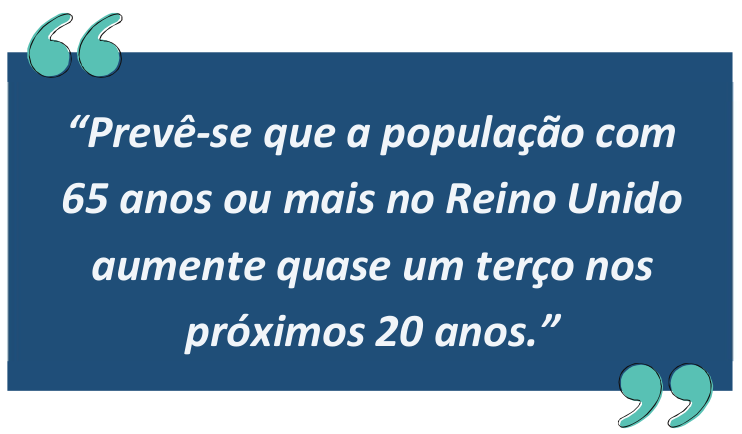
Fonte: ONS (2022), Projeção principal – População do Reino Unido em grupos etários. Disponível em: ONS Population Projections
Será que o aumento da esperança de vida é o segredo para uma boa vida? Parece que não é assim tão simples. Os mais velhos precisam de muito mais para alcançar o que a OMS define como "envelhecimento saudável". Este conceito assenta em três pilares fundamentais: limitar a incapacidade associada à doença, manter uma elevada função cognitiva e física, e fomentar o envolvimento social (Morley, 2015). Além disso, o "envelhecimento saudável" está fortemente ligado ao conceito de "envelhecimento no local", que promove a continuidade da vida em casa, preservando a independência, o contacto social e a dignidade. Este estilo de vida não só tem um impacto profundo na saúde física e mental dos idosos, como também é percecionado por eles como mais desejável, satisfatório e recompensador (Puri et al., 2017). Afinal, não é apenas sobre viver mais tempo, mas sobre viver com qualidade — e, de preferência, no conforto do lar!
Por mais apelativo que o conceito de "envelhecimento no local" possa ser, não resolve diretamente o problema das doenças degenerativas e relacionadas com a idade, que continuam a ser as principais causas de mortalidade atualmente (Araullo & Potter, 2016). Este desafio tem impulsionado o desenvolvimento de tecnologias de monitorização da saúde, como os wearables. Estes dispositivos oferecem funcionalidades como lembretes para a toma de medicação, sistemas de prevenção e deteção de quedas, e até a transmissão de dados médicos diretamente para centros de saúde (Li et al., 2019; Puri et al., 2017). Mas será que existe uma alternativa ou complemento para minimizar o impacto destas condições? Felizmente, a resposta é sim. E, como veremos, esta abordagem combina tecnologia com a promoção de estilos de vida saudáveis, demonstrando que cuidar da saúde pode ser tanto uma questão de prevenção como de inovação.
Στις περισσότερες σύγχρονες κοινωνίες που η τεχνολογία και η ιατρική έχουν προχωρήσει δραματικά, ο γηράσκων πληθυσμός αυξάνεται λόγω της παράτασης του προσδόκιμου ζωής (Gu, Andreev &; Dupre, 2021). Ωστόσο, η αύξηση του προσδόκιμου ζωής δεν σημαίνει ότι ο γηράσκων πληθυσμός ευημερεί· Η μακροζωία χωρίς ανεξαρτησία και αξιοπρέπεια, μπορεί να φαίνεται κάπως ανάξια. Όλοι έχουμε γίνει μάρτυρες με τον ένα ή τον άλλο τρόπο ηλικιωμένων που θα μπορούσαν να ζήσουν μέχρι την ηλικία των 95 ετών, αλλά πέρασαν την τελευταία δεκαετία τους στο κρεβάτι, απόλυτα εξαρτημένοι από τα φάρμακα και φροντισμένοι από άλλους ανθρώπους - ηλικιωμένοι που πέρασαν τα τελευταία τους χρόνια σε οίκους ευγηρίας νιώθοντας δυστυχισμένοι, με μόνη ελπίδα να δεχτούν μια επίσκεψη από τα παιδιά τους μία στο τόσο - ηλικιωμένοι που ζουν μόνοι χωρίς κοινωνικές συνδέσεις αισθάνονται μοναξιά και αποσυνδεδεμένοι από τον υπόλοιπο κόσμο.

Πηγή: ONS (2022), Principal projection – UK population in age groups. Διατίθεται στη διεύθυνση: ONS Population Projections
Είναι, λοιπόν, η αύξηση του προσδόκιμου ζωής το βασικό συστατικό της συνταγής που ονομάζεται επιτυχημένη και ικανοποιητική ζωή; Φαίνεται ότι δεν είναι. Οι ηλικιωμένοι χρειάζονται περισσότερα από αυτό για να επιτύχουν αυτό που οι επιστήμονες αποκαλούν «επιτυχημένη γήρανση». Η επιτυχής γήρανση βασίζεται σε τρεις συνιστώσες: περιορισμένη αναπηρία που σχετίζεται με ασθένεια, υψηλή γνωστική και σωματική λειτουργία και συνεχή δέσμευση με τη ζωή (Morley, 2015). Έχει επίσης προταθεί ότι η επιτυχής γήρανση μπορεί να επιτευχθεί μέσω της επιτόπιας γήρανσης, μια έννοια που απεικονίζει τη συνεχιζόμενη διαβίωση στο σπίτι, διατηρώντας παράλληλα την ανεξαρτησία, την κοινωνική επαφή και την αξιοπρέπεια, επηρεάζοντας βαθιά την υγεία και την ψυχική κατάσταση των ηλικιωμένων και γίνεται αντιληπτή από τους ηλικιωμένους ως πιο επιθυμητή, χαριτωμένη και ικανοποιητική (Puri et al., 2017).
Ωστόσο, ανεξάρτητα από το πόσο ελκυστική ακούγεται αυτή η έννοια, δεν καταπολεμά άμεσα το γεγονός ότι οι ηλικιωμένοι εξακολουθούν να υποφέρουν από εκφυλιστικές ασθένειες και ασθένειες που σχετίζονται με την ηλικία, οι οποίες είναι οι κύριες αιτίες θνησιμότητας σήμερα (Araullo &; Potter, 2016). Αυτό έχει οδηγήσει στην αύξηση των φορητών τεχνολογιών παρακολούθησης της υγείας, από υπενθυμίσεις φαρμάκων και πρόληψη και ανίχνευση πτώσης έως δεδομένα φυσικής κατάστασης που μεταδίδονται απευθείας σε ιατρικά κέντρα (Li et al., 2019; Puri κ.ά., 2017). Υπάρχει, όμως, άλλος τρόπος που μπορεί να αποτρέψει ή τουλάχιστον να μειώσει τις επιπτώσεις αυτής της κατάστασης; Ευτυχώς, υπάρχει.
